Plumerias are so exotic and beautiful that it seems like they would be difficult to care for. But they’re actually quite easy to grow once you learn how.
In this post, I’ll tell you all you need to know about how to grow plumerias, including water, soil, fertilizer, and light, as well as tips one propagating, pruning, flowering, and more.
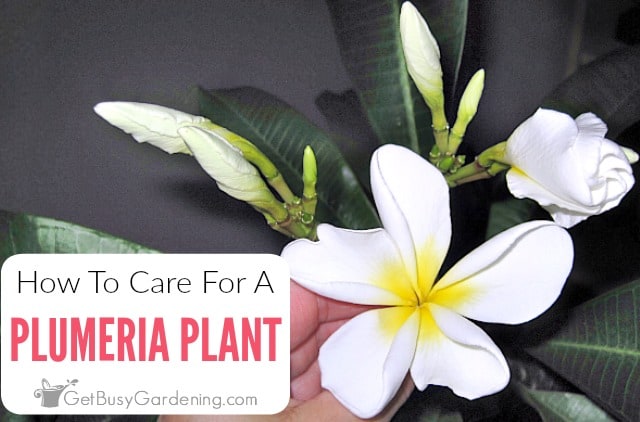
When I think back to my trips to Hawaii, one thing that I remember the most was all of the gorgeous plumerias growing and blooming everywhere.
So of course, I absolutely had to bring one home with me when I went back to Minnesota.
My new baby Hawaiian lai plant was only about a foot tall when I got it, and it bloomed shortly after I brought it home.
I instantly feel in love, and was pleasantly surprised by how low maintenance it was. If you want to try one for yourself, then you’re in the right place.
Below I’ll tell you everything you need to know about their care, and show you how to grow plumeria no matter where you live.
Plumeria Quick Care Overview
| Scientific name: | Plumeria |
| Classification: | Tropical plant |
| Common names: | Frangipani, Hawaiian Lei Plant, Kalachuchi, Champa Flower |
| Hardiness: | Zones 10+ |
| Temperature: | 60-75°F |
| Flowers: | Colors and bloom times vary by species |
| Light: | Full to partial shade, bright light indoors |
| Water: | Allow soil to dry slightly, do not overwater |
| Humidity: | Moderate to low |
| Fertilizer: | Flowering plant food in spring and summer |
| Soil: | Fast-draining, fertile soil |
| Common pests: | Spider mites, whiteflies |
Information About Plumerias
Plumerias are popular tropical plants that can grow into huge trees in their native environment.
You might know them better as a Hawaiian Lei Plant (plumerias are the type of flowers traditionally used to make leis), or maybe by their less common name, Frangipani.
But don’t let their common name fool you, they aren’t actually native to Hawaii. They’re originally from the tropical regions in Central and South America, as well as parts of the Caribbean.
Different Types Of Plumeria
There are several different varieties of plumerias, some can become large trees, while others are smaller shrubs. But they all require the same care and attention. Here are a few of the most common.
- Plumeria pudica – Also known as Bridal Bouquet because of the white flowers, this is one of the hardier varieties that can survive down to zone 9. It can reach 15-20′ tall.
- Plumeria rubra – This is one of the more common types, and there are several hybrids. Depending on the cultivar, they can grow anywhere from 6-30′. The flowers come in just about any color too, and some can bloom year round.
- Plumeria obtusa – There are a few cultivars of this one too, many of which are shorter dwarf varieties. Colors and bloom times also vary between them.
- Plumeria alba – Sometimes commonly called a Nosegay Tree, this species is another one that can grow 6-30′ in height.
Flowers
As I’m sure you probably already know, plumeria is prized for their gorgeous, and highly fragrant flowers.
Depending on the species, they can be just about any color, and some individual blossoms even contain more than one.
The time of year totally depends on the variety. Some only flower in late winter through spring or summer, while others will bloom profusely all year long.

Toxicity
The sap can cause irritation for those with sensitive skin, and is also toxic to cats, dogs, and people if ingested.
Though they’re only mildly poisonous, it’s best to keep them out of reach of your kids and pets if this is a concern for you. The ASPCA website is a great source for more information.
How To Grow Plumeria
Before we jump into the details of plumeria plant care, first we should chat about where to grow them. Choosing the right location is key to long-lasting, sustained health.
Hardiness
Most frangipani plants can only live outdoors in zones 10 or higher, though there are few that can survive down to zone 9.
They’re very sensitive to the cold, and will drop their leaves or turn yellow or brown in the fall, even in warmer areas.
Where To Grow Plumeria Plants
In warm enough climates, plumerias can grow into very large trees, so they will need a lot of space in your yard.
If you want to restrict their size, you can put them in a container instead of in the ground, they do very in pots.
They can also thrive indoors in a spot with plenty of light. Although it’s very uncommon for them to bloom inside the house.
For that reason, I find it’s much easier to put them outside in the summer to maintain their health and growth, and also encourage flowering.

Plumeria Plant Care & Growing Instructions
With the proper care, plumerias can live for many years. Now that you know where to plant them, let’s chat about their needs. Follow these tips to keep your plumeria growing and blooming year after year.
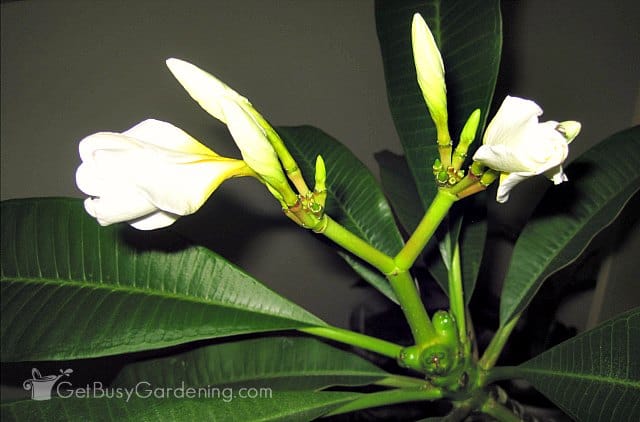
Watering Requirements
Plumerias like a lot of water, but won’t tolerate being overwatered. When they’re too wet, the trunk will rot, and it will eventually kill the plant.
It’s kind of a funny combination, give it a lot of water… but don’t overwater? I know, but don’t worry it’s actually pretty easy. A moisture gauge will help you get it right.
During the summer months, give it a really good, deep drink. Allow the excess to drain completely, and wait until it’s mostly dry before adding more.
Since they go dormant during the winter, it’s best to water them very sparingly, if at all, during those months.
Humidity
You might be surprised to learn that plumeria plants prefer moderate to low humidity levels.
If it’s extremely dry in your home, you can place a humidifier next to it to help add extra moisture to the air.
However, be careful misting or spraying them with water, you don’t want to overdo it. If droplets are constantly sitting on the branches or leaves, it could cause them to rot.
Light Requirements
Plumerias need full sun in order to grow their best and also to bloom, otherwise they will become sparse and leggy.
If yours is outside, put it in a full sun location. Otherwise if it’s indoors year round, then you’ll likely need to get a grow light.
When you move it outside for the summer, don’t give it full exposure right away, or it could burn. Instead, put it in the shade for a few days, and gradually introduce it to a full sun location.
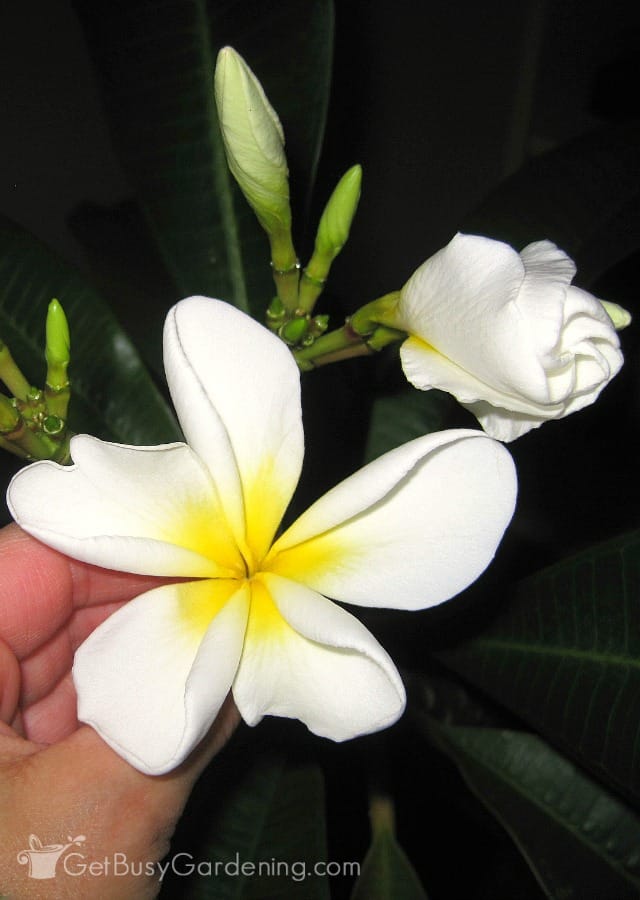
Temperature
Plumerias are not cold hardy plants. Their ideal temperature range is between 60-75°F.
If it gets much colder, they’ll start dropping their leaves, and below freezing temps will quickly kill them. Even a light frost can damage the tender branch tips.
Hotter weather doesn’t often bother them, though the high heat in arid climates will dry them out too quickly.
Best Soil
The best soil for successful plumeria plant care is a fast draining mix that’s slightly acidic, ranging between 6-7 on a pH meter.
You don’t necessarily need to buy any special type, and you can even make your own if you want.
I grow mine in a homemade mixture of 2 parts general purpose soil with 1 part each of either perlite or pumice, and sand.
Find out more about how to choose the best soil for your plumeria, including my recipe to make your own in my detailed guide.
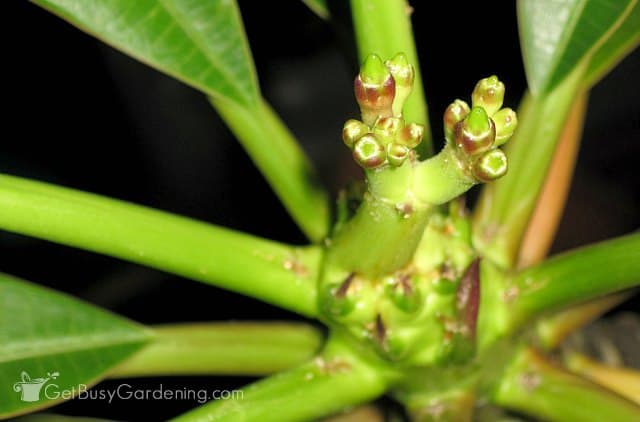
Fertilizer
As I already mentioned, plumerias are very heavy feeders, and fertilizing is an important part of their care.
They need a type that is high in phosphorus in order to bloom. Apply an organic liquid flower food every 1-3 weeks in the spring and summer. You can also apply granules monthly to provide even more nutrients.
Fertilize them from spring through summer, and stop in early fall. Then don’t feed them at all during the winter.
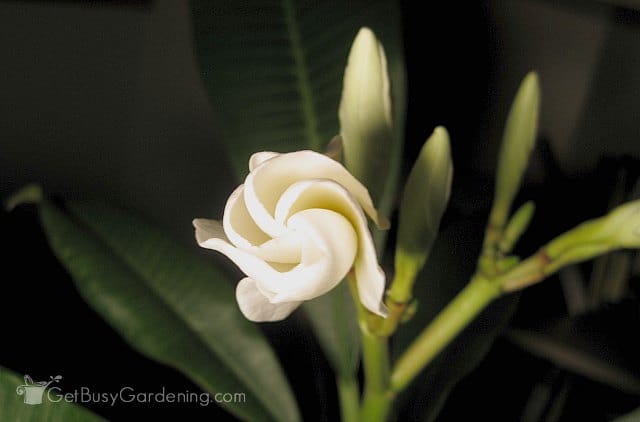
Repotting
With the proper care, frangipani trees can grow very rapidly, and may need repotting every 1-2 years.
When roots begin to come out of the drainage holes, or growth slows, it’s a sign they need to be sized up.
In the spring, move them into a container 2-4” larger than the current one. Replant it at the same depth, and expect some leaf drop or drooping as they recover.
If you want to limit their size, simply refresh the top few inches of soil and trim away some of the roots.
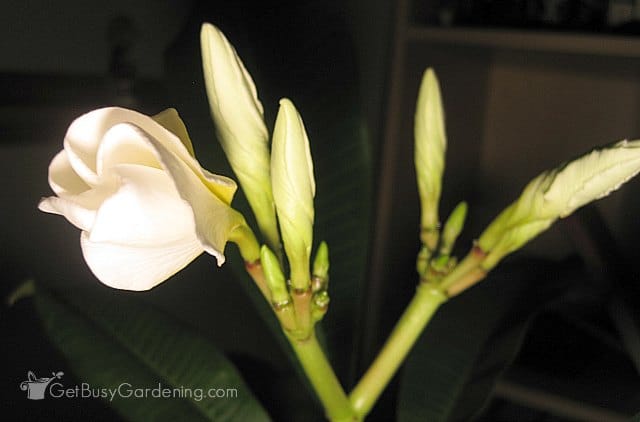
Tips For Controlling Plumeria Pests
Though pests aren’t usually an issue outdoors, plumerias can have problems with spider mites and whiteflies indoors.
If yours gets attacked by bugs, begin treating it right away. I recommend using neem oil, which is a natural pesticide that works great.
Organic insecticidal soap is also a good option. I sometimes make my own by mixing 1 tsp mild liquid soap per 1 liter of water.
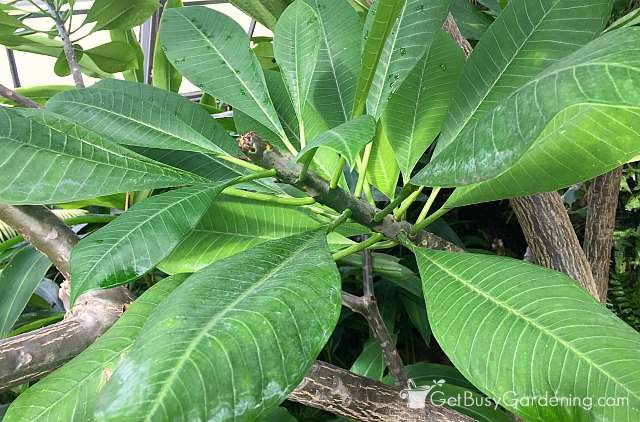
Pruning
Plumeria plants benefit from regular pruning as a part of their care routine. They can handle being trimmed back pretty severely, but never cut them all the way down to the ground.
The best time to do it is in the spring, or right after they’re done blooming.
Use sterile and sharp pruning shears so you get a nice clean cut. For thicker branches, you may need to use a lopper. Also, wear eye protection and gloves to protect against the sap.
Always make your cuts at a downward angle, so water can’t settle into the wound and cause the branch to rot.
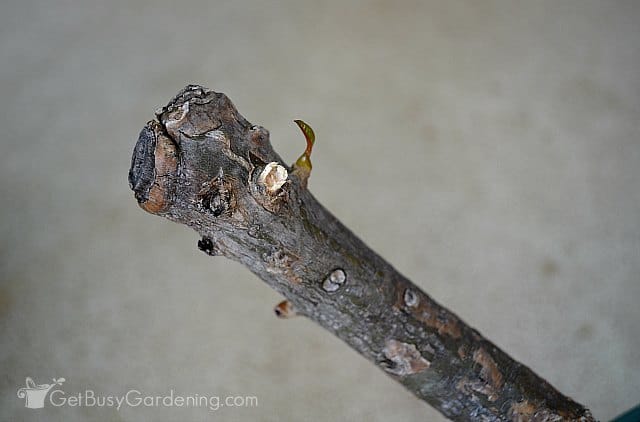
Plumeria Propagation Tips
Though they can be grown from seed, most home gardeners propagate their plumeria by taking cuttings.
It’s pretty easy to do. Simply take a section from a healthy branch, remove the flowers and leaves, and allow it to cure for several days.
Dip the cut end in rooting hormone, then place it into a slightly moist medium. Keep it in a warm spot until you see new growth on top. Get my step-by-step tutorial for how to propagate the cuttings here.
Plumeria Winter Care & Dormancy
Once the temperature starts to cool in the fall, and there’s less sunlight, your plumeria will start to go dormant naturally. This is the time to stop fertilizing, and slow down on watering.
The leaves will turn yellow and then brown before finally dropping off. This is totally normal, so don’t panic. It might not drop all of the leaves though, and that’s ok too.
If you live in a cold climate, this makes is much easier to overwinter them indoors. So there’s no need for artificial lights or a sunny window.
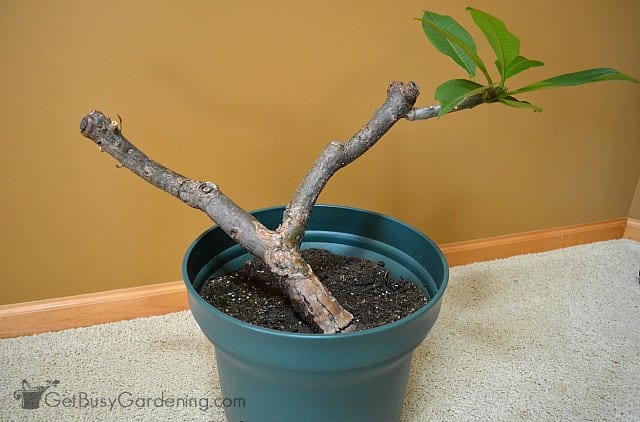
Troubleshooting Common Plumeria Care Problems
Though plumeria are fairly simple to care for, they are notorious for having a few problems. Below I’ll help you troubleshoot and fix the most common issues.
Tip Rot
In my experience, tip rot is a pretty common problem. It happens when water settles in a crack or wound on the end of a branch, which is usually caused by improper pruning or frost damage.
If left untreated, the rot will spread, and could eventually kill the plant. You can save it by cutting off all of the rotted pieces of the affected branch.
Stem Rot
If the stem is mushy and rotting at the base, then you have a more serious problem. Stem rot is caused by overwatering.
If left untreated, your plant will die for sure. If the rot isn’t too severe, you can save it by taking cuttings of the healthy stems or branches and rooting them.
Plumeria Won’t Bloom
This is probably the #1 question I get asked about growing plumerias, and there is one simple answer… fertilizer.
They need fertilizer in order to bloom, and lots of it. The good news is that it’s such an easy fix. Once you get the hang of it, they will flower profusely for you.
Leaves Falling Off / Dropping
Leaf drop can be caused by a lack of water or cold temperatures. It’s natural for them to go dormant during the winter when it gets below 50°F, and this is nothing to worry about.
However, if it happens during the summer, then check to make sure they’re getting enough water. They should never dry out completely. Also inspect the branches and trunk for signs of rot.
Leaves Turning Yellow
Yellow leaves are also a sign that they’re starting to go dormant, however it could be from overwatering, pests, or disease.
Check the soil to make sure it’s not wet or soggy, inspect the leaves for bugs, and verify that the stems are firm and not rotting.
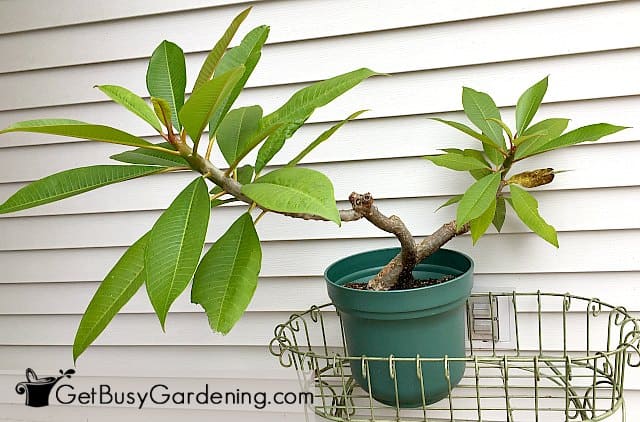
FAQs
In this section I’ve answered some of the most frequently asked questions about plumeria care. If yours isn’t listed, please ask in the comments below.
Are plumeria hard to care for?
No, plumeria are not hard to care for. They’re actually quite easy to grow, as long as you understand their requirements.
How long does it take for a plumeria to be full grown?
How long it takes for a plumeria to be full grown totally depends on the variety. Some grow must faster than others, though on average they can put on 12-36″ per year with the proper care.
Is plumeria an indoor or outdoor plant?
Plumeria can be either an indoor or outdoor plant, depending on where you live. They’re only hardy in the warmest regions, so people in cold climates must bring them indoors during winter.
Is plumeria a succulent?
No, technically plumeria is not a succulent, they are tropical plants. Though they do have some similar care requirements and properties.
Is frangipani the same as plumeria?
Yes, frangipani is the same plant as plumeria. Frangipani is the common name for them. Plumeria is technically the scientific name, though many people also call them that since it’s easier to pronounce.
Plumerias are wonderful plants that are surprisingly easy to care for. Once you know the tricks for growing them, you’ll be able to keep yours thriving for decades to come.
If you want to learn all there is to know about maintaining healthy indoor plants, then you need my Houseplant Care eBook. It will show you everything you need to know about how to keep every plant in your home thriving. Download your copy now!
More Houseplant Care Guides
- How To Grow Begonia Plants
- Wandering Jew Plant Care & Growing Guide
- African Milk Tree: How To Grow & Care For A Euphorbia trigona Plant
Share your plumeria plant care and growing tips in the comments section below.


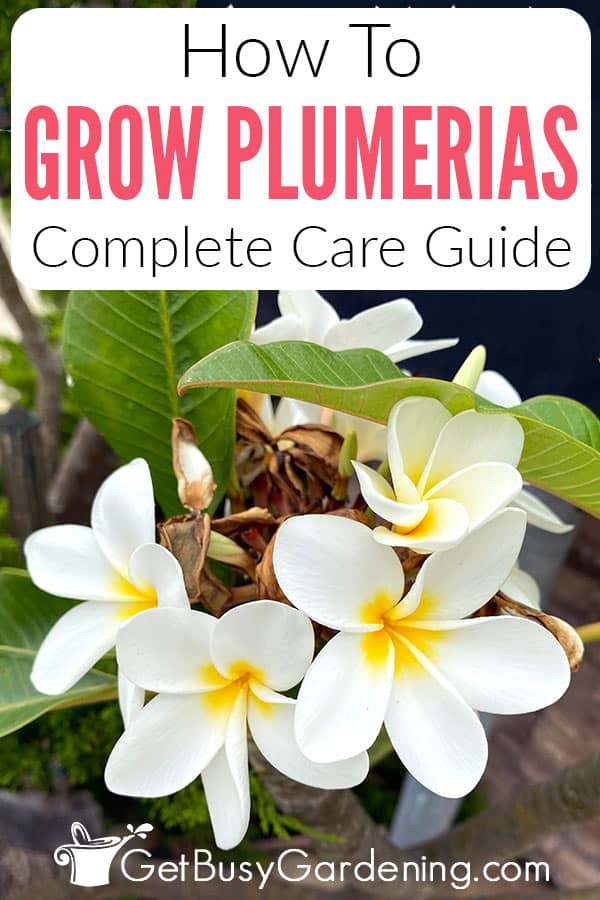
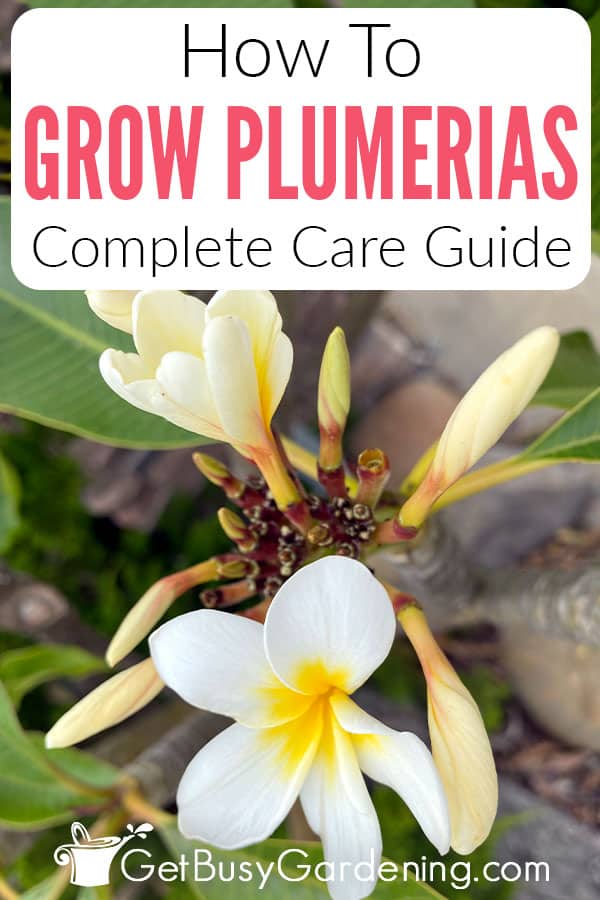
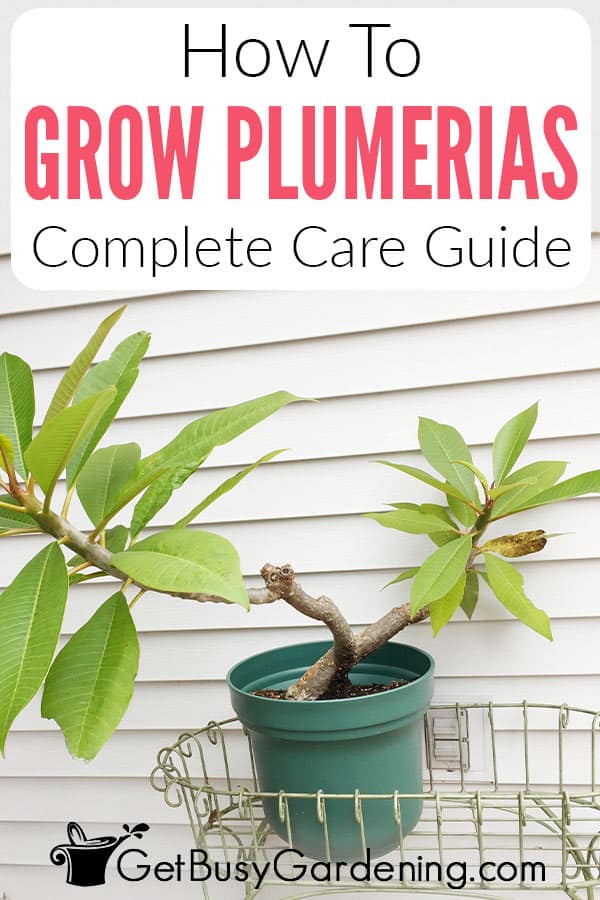
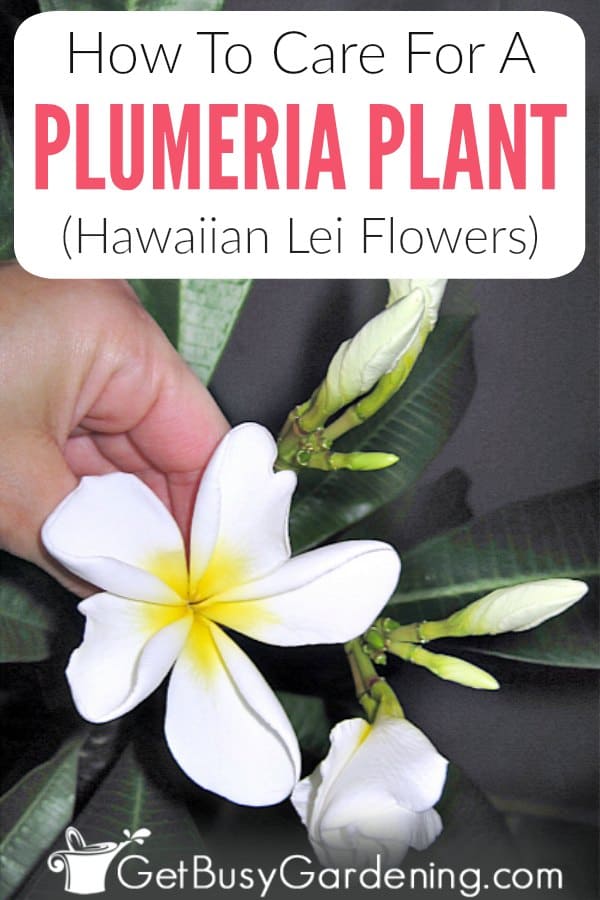



Tracie says
My plumeria leaves appear droopy. Stem is solid, soil seems moist and the green color is nice. Am I not watering enough?
Amy Andrychowicz says
Normally I would say that your plumeria was being under watered, but you mention that the soil is moist so that’s confusing. Did you just water your plumeria after a period of drought? If so, then it will pop back in a day or two. Otherwise, if the soil is moist, then don’t water it until it has dried out again. If the leaves are still drooping after a few days, then check the stem again to make sure it’s not becoming soft. Check the full length of the stem, because plumeria plants can start to rot anywhere on the stem if water gets into a wound.
Charlie Walch says
Amy, I have a plumeria in a pot outside the roots have come out the bottom of the pot and has rooted in the ground. I want to put it a bigger pot. Will I kill the plant if I pull the roots out of the ground? I have not had blooms on it in two years. I live in north Florida and the soil is about 60 % sand. My soil in the pot gets hard from time to time but I do water it every three days. Any suggestions?
Amy Andrychowicz says
It depends on how deep the roots have grown into the ground. If they are really shallow, then I would just pull them out. But if they have grown pretty deep, and the pot isn’t easy to pull up, then I would cut the roots off at the bottom of the pot. It definitely sounds like you need to repot your plumeria into a large pot to give it more room to grow.
Nikki says
I have several plumerias and one of them in particular has these deep splits in the trunk and I can’t figure out why. None of my others have this issue, I originally thought maybe I wasn’t watering enough but my others are fine. Any ideas? I have pictures if needed.
Amy Andrychowicz says
Splits and cracks in the trunk is a pretty common problem for plumerias, and some varieties are more prone to it than others. It can be caused by extreme temperatures (extreme heat or freezing temps) or by inconsistent watering.
eiwin says
Will the splits kill the tree.
Amy Andrychowicz says
A split in the trunk of a plumeria plant is an open wound, which can lead to fungus or pest problems. Splits and cracks can also be spots for water to pool, which can cause the trunk or stems to rot. So, yes, they could end up killing the plant… but the splits themselves don’t hurt the tree.
Velvet says
I use a Pruning sealer, works great for wounds.
Micah Cheng says
I am new to plumeria. I currently have 6 mixed cuttings in the rooting process with signs of new growth. My question is regarding pruning in the future. If I prune my plumeria in spring will the new growth bloom that same summer, or it doesn’t bloom on new growth?. For I just got my cuttings in June from Disney springs Florida and I live in Lexington Kentucky which gets cold in the winter. So I will need to bring them in for the winter. Thanks in advance for your answer.
Have a great day.
Amy Andrychowicz says
Congratulations on successfully propagating your plumeria cuttings, that’s so exciting!! The best time to prune your plumeria plant is after it’s done blooming. If you prune it in the spring before it blooms, you will be cutting off all the future flowers, and it probably won’t bloom again until the following year. Good luck, and enjoy your new plumerias!
Irene ourng says
Hi my name is Irene. I have learned a lot from you. But I have a question. My plumeria’ s stem were dry and the leaves start to turn yellows. I do not know what to do. The soil is dry. Should I water more or cut down watering the plants. Please help me. Thank you so much.
Amy Andrychowicz says
Hi Irene! I’m so happy to hear you’ve learned so much from me, that’s fantastic! 🙂 As for your plumeria… if the stem is dry, and the soil is dry then it sounds like you need to water it more often. Plumeria plants like to be watered more often during the summer, and then kept on the dry side through the winter when they go dormant.
Cora says
While reading about plumerias, two articles mentioned “bloom pods that will keep producing flowers after flowers fall off.” I have googled bloom pod images and can only find images and info on seed pods. What is a bloom pod?
Amy Andrychowicz says
I’m not sure what they’re referring to either, I’ve never heard that term before. Maybe they just meant the grouping of buds before they open? Each plumeria flower spike will have several flowers on it, and they usually open at different times.
Velvet says
I think they are talking about the spikes too
Deborah Stanger says
I’m still a bit confused about pruning. Where on the plant should I cut? Can these cuttings be used to propigate?
Amy Andrychowicz says
It’s ideal to cut back a plumeria branch to the stem it’s growing from. But, plumerias aren’t fussy, and they will get new growth just below any cut you make. Just be sure to make the cut at a downward angle so water can’t settle into the wound (plumerias are very susceptible to tip rot). That’s the most important part about pruning them. And yes, you can propagate the cuttings. Ideally the cutting would be at least 8″ long for propagation, but you should be able to propagate shorter cuttings too. Here’s how… How To Propagate Plumeria From Cuttings
Kitty Martin says
Do you put the cutting in water to root or directly into plumeria potting soil?
Amy Andrychowicz says
Allow the plumeria cutting to dry out (cure) for a few days so it scabs over. Then dip the cutting in rooting hormone and put it into the potting soil. Keep the humidity high around the cutting, but the soil on the dry side. Once you start to see new growth on the cutting, that’s a sign it has roots. Here are step-by-step instructions for propagating plumeria cuttings.
Susan Horn says
I’m having an issue with my plumeria after a recent storm knocked the pot over. The bottom or root of the plant is brown and flakey, always has been, but more so now. The stem is still firm and the plant looks healthy, but I’ve noticed a bit of droopiness and want to save it.
What should I do? I’ll see if I can send photos…
Amy Andrychowicz says
It might just be drooping because it’s unhappy (and in a bit of shock) after being disturbed. I would give it a few days, and keep checking the stem to make sure there’s no sign of rot. It should pop back after a few days.
Cynthia Phillips says
I have had several plumeria branches break off during a storm, they have blooms on them. How do I transplant them?
Amy Andrychowicz says
Plumeria cuttings are pretty easy to propagate. Remove the blooms and leaves, and allow the wounds to callus over for a few days before you try it. Here’s a post I wrote with step-by-step instructions… How To Propagate Plumeria From Cuttings
Vicky Cintron says
Thank you so much for the great advice! I have two awesome 8ft pink and red Plumerias, which have only bloomed once in the past 3 years, even though I live in tropical Puerto Rico. I now hope I can get them to bloom by fertilizing often. I have never trimmed them, because I didn’t know they were easy to propagate. I am looking forward to having newbies! Thank you.
Amy Andrychowicz says
Awesome, so glad you found the post useful! Here’s a post I wrote with detailed propagation instructions… How To Propagate Plumeria From Cuttings
Rhony says
WOW. My cutting was “forgotten “on my workshop table and crusted over, dry ,and sad. I suppose about 8 or 9 days..Silly me planted it anyway, grew like “the best” . I will “crust” over all cuttings from now on ?.!!Had to share.
Amy Andrychowicz says
Awesome, congrats on having such great success propagating your plumeria!! Allow the cuttings to callus over is definitely a key point for success. 🙂
Beth says
My single stem Plumeria has an inch long stem (not a branch) in the middle of the three branches at the top of the plant. I have never seen this before. All of my books and research don’t describe this particular growth. Do you by chance know what it is? I am guessing a possible seed pod as it definitely is not a branch, leaf, or flowering bud.
Thanks for any help
Beth
Amy Andrychowicz says
Sounds weird. The way your describing it, I would have guessed it was a flower spike starting to grow. It’s hard to know without seeing a photo. You can share a photo to my Facebook page if you want, and I can see if I can ID it. Plumerias can grow seeds, so it very well could be a seed pod. Fun!
Velvet says
Mine did this after it branched off. It was actually where it’s very first bloom spike was.
Nicole says
That is really cool how plumeria plants can be propagated like succulents. The flowers smell so good!
Amy Andrychowicz says
Yes, I love that it’s easy to propagate my plumeria! Here’s a post I wrote with step-by-step instructions… How To Propagate Plumeria From Cuttings
Kathy says
I have no problem getting my plumeria to bloom. I have a ten footer now and have had to keep cutting it back so it doesn’t hit the ceiling. I got it on my honeymoon 32 years ago. Have many small ones as well from the cuttings. Once the plant gets about 3ft tall it can bloom if it gets at least 4 hrs of sun. The way I get them to bloom is when I put them out in the spring, I spray diluted fertilizer on the plumeria leaves. Some plants will respond quickly and throw up a bloom stalk in june. Others have bloomed in the middle of winter indoors.
Amy Andrychowicz says
Awesome, thanks so much for the tips! I usually let my plumeria go dormant during the winter because I have such a problem with whiteflies and spider mites. Maybe I’ll try keeping it going this winter to see if I can get it to bloom again.
Kitty says
I am having problems with white flies and spider mites on my plumeria. My potted plant is on my balcony. I have sprayed it 3 times with soapy water but the bugs still persist. Amy, how did you get rid of these pests?
Amy Andrychowicz says
Neem oil! It works great to get rid of both spider mites and whiteflies. 🙂
Kitty Martin says
Thank you!
April says
Thank you for the insight on neem oil. do you rub on the leaves, put in a spray bottle with a mixture of water? how do you ensure it gets everywhere?
Amy Andrychowicz says
You’re welcome, glad I could help! Here’s a post I wrote about neem oil, and how to use it. 🙂 How To Use Neem Oil Insecticide To Kill Bugs On Plants
Kathy says
You are probably better off letting it go dormant. I fight the white flies or spider mites every winter. My plumeria trees rarely stay in dormancy for the whole winter so it becomes an annual battle.
Linda Good says
put baking soda in your soil keeps all insects out of your plants
Amy Andrychowicz says
I’ve never heard of that before, or tried it myself. I might have to test it on a few of my plants this winter. Thanks for sharing your tip.
Kitty Martin says
I am a little leery to use baking soda in the soil until I hear from more people that it works. I am now using Neem oil on my plumeria. I previously used a recipe from another site which had vinegar, baking soda, oil and liquid soap, and it almost killed my plumeria. I had to cut it completely back and I’m hoping it will come back. From everything that I’ve read, it should, but I’m being very careful with it now.
Amy Andrychowicz says
I don’t blame you at all Kitty! I would definitely test it out first (maybe on a plant that’s not as important to you) before applying it to all of my plants. That recipe you got from that other site sounds just like a recipe I use to KILL weeds in my garden! YIKES! I’m glad your plumeria recovered. Never spray vinegar or kitchen/cooking oil on plants, and be very careful with the type of soaps you use too. Some contain detergents and degreasing agents that can harm sensitive plants.
KATHY says
Beware of using tobacco tea to get rid of pests. I was told this would work, but it caused leaf deformities for an entire growing season. Thought I killed it. Thankfully it recovered but would not do that again.
Amy Andrychowicz says
Wow, you fertilize your plumeria that often? I will have to try that next summer. I let my plumeria go dormant in the winter so I don't have to deal with the pests.
Diane Sheridan says
Thanks for the great advice this was the most I got on this plant I was given 7 from Hawaii from cousin and I am really shocked that one has bloomed I so excited it smells wonderful wish me luck for the winter
See u in spring
Amy Andrychowicz says
You’re welcome! Good luck! I’m excited for you, and happy to hear that one of your plumeria plants has already bloomed. How fun!
p3chandan says
Actually I fertize mine once a fortnight, whether its blooming or not..
p3chandan says
Hi Amy, plumeria (common name frangipani) needs full sun to bloom and regular fertilising thats what I found out with my own plant. Dont worry, it can be propagated using mature stems.So you can have many more seedlings!
CJ says
Not sure how old this post is as I can’t find a date! I brought a plumeria branch back with me from vacation. The branch I then cut in half. The one that had leaves on the end has six new leaves! The other end with the open wound hasn’t shown any growth. Does it now come out the sides is what I assume? I’m on the Central Coast of CA. Pismo Beach will it bloom here? Yea, I know no way of knowing! Thanks for any info.
Amy Andrychowicz says
I keep my posts updated all the time, so they are always fresh! 😉 Congrats on the new leaves on your plumeria cutting, how exciting! Yes, the other one will start to grow new leaves on the sides. Usually it will start to grow just below the cut, but it could start growing somewhere else along the stem as well. Plumerias usually bloom in the spring through summer in their natural environment.
Gloria Dowdy says
I am new with this plant growing. I bought a new house and the pumeria plant was left to me. I left it outside through Thanksgiving and I believe it was frost bitten. I brought it inside to try to save it. I knew nothing about dormant…I completely panicked. I pampered it, bought a plant light, and watered it carefully. The tip has turned a light green color and new leaves are beginning to sprout out. The stem of the plant is turning from the grayish color to a dark green color. Now reading your growing tips, I am afraid that I have caused a problem in bringing it out of dormancy. It is now New Years Eve. Please give me some advise. Thank you.
Amy Andrychowicz says
I think it should be fine. Just be sure you don’t overwater your plumeria through the rest of the winter, and keep an eye on it to make sure it doesn’t get bugs on the leaves as they grow. Spider mites and whiteflies are very common on plumerias, but easy to control. Good luck!